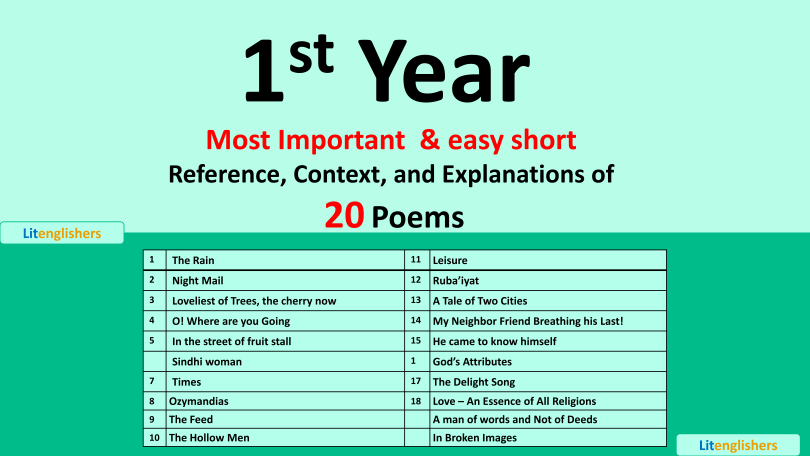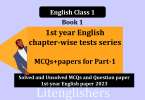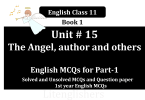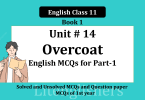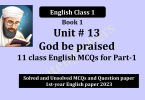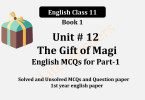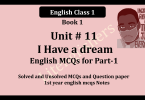1st Year English Poems with Reference, Context, and short Explanation
This is one of the best pieces of 1st Year English Poems Notes. This is written in a very well manner especially concerning normal students so that we can understand easily and get at least 80% marks. The right hemisphere controls our imagination and visual and spatial perception. It is responsible for the perception of art, music, and our physical movements. We will be happy if you share your thoughts or any kind of problem you face during reading and downloading the Poems in our comments section. Feel Free to contact us.
We know its too difficult to learn 20 poems’ explanations and contexts and especially for those who always prefer cramming to learn the lesson but in a 1st-year poems explanation you need to be a little self-writer because the explanation means you express your thoughts about what you assume after reading the poem or reading the lines but some students do not get that grip so for such students we provide easy-peasy short References and Explanations of the Poems that they can learn without any trouble and get almost 80% marks in it.
Before starting over we need to know what reference, Context, and explanation are.
What is Reference?
A reference is a word or idea which comes from something like books, poems, or plays and tells from where the information is obtained such as the name of the writer, or translator and books, poems, or plays.
What is the context?
Context is the information that helps the message of a literary text make sense and inform about an event, an idea, or a statement. overall we can say it is the overall detail that adds meaning to the text.
What is an Explanation?
The act or process of explaining to make something clear cut or describes the facts about that statement, its causes, and contexts.
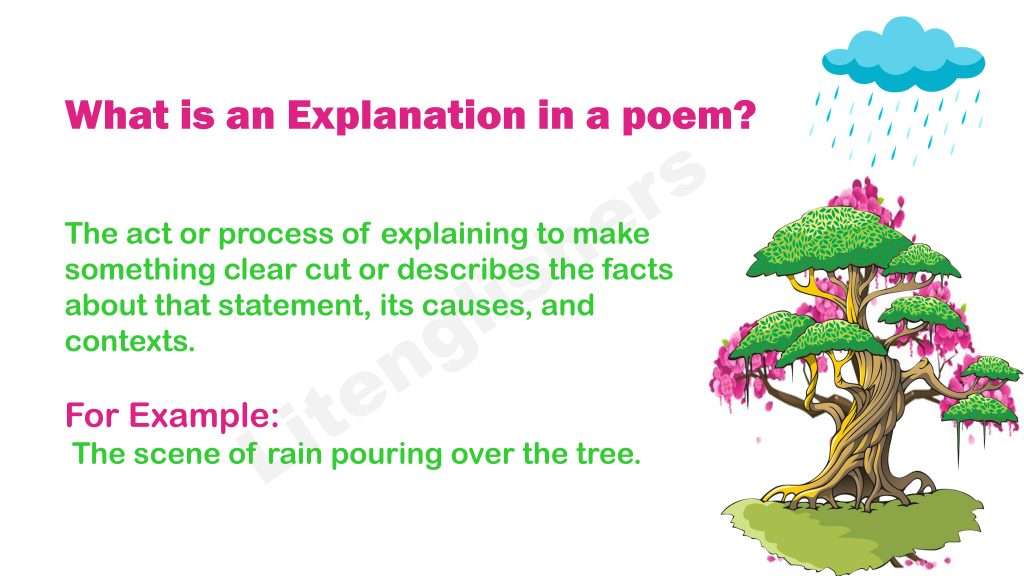
(1) The Rain by
W.H.Davies
Reference: These lines have been taken from the Poem, “The Rain” written by W.H.Davies.
Context:
In this poem, the poet tells us that rain makes everything fresh and this poem describes the beauty of nature. After the rain, the sun shines and makes the scene lovely.
Explanation:
W.H.Davies is a great poet of English literature and this poem is a masterpiece of his poetic work. In this poem, the poet tells us his personal experience that he hears the sound of raindrops falling on leaves. It creates a musical sound. The poet enjoys the music. Though rain creates a disturbance for the poor taking shelter under the tree. They have to suffer wet cold weather. The leaves on top are drenched with water. They receive more rainwater. The leaves below are pale. They get very little water. The poet hopes the sun will appear and brighten everything. Its rays brighten the raindrops and lend them different colors.
Critical appreciation:
It is a symbolic poem. The leaves symbolize humans. The green leaves symbolize the rich and the yellow the poor. Rain symbolizes resources, the sun symbolizes divine light.
(2) The Night Mail
by W.H.Auden
Reference: These lines have been taken from the Poem, “Night Mail” written by W.H.Auden.
Context:
In this poem, the poet tells us about the journey of the train that brings mail at night, It reaches on time.
Explanation:
W.H.Auden is a great poet of English literature and this poem is a masterpiece of his poetic work. In this poem, the poet tells us his personal experience when he describes the journey of a train that travels at night. It brings letters, postal orders, and cheques for the rich and the poor. Sometimes it goes upward and sometimes it travels straight. It always reaches on time. Producing noise, it passes by grassland, cotton fields, and plains. The birds stare at its blank coaches from their nest and the sheep dogs continue their sleep without bothering about it. When it passes by a farmhouse, no one wakes. Only Jug and glasses in the kitchen shake.
Critical Appreciation:
It is a charming poem. The train is personified as a calm and kind being.
(3) Loveliest of the Tree, the Cherry Now
by A.E.Housman
Reference: These lines have been taken from the Poem, “Loveliest of the tree, the cherry now” written by A.E.Houseman.
Context:
In this poem, the poet tells us about the beauty of the cherry tree. It looks very lovely in spring.
Explanation:
A.E.Hoseeman is a great poet of English literature and this poem is a masterpiece of his poetic work. In this poem, the poet tells us about his personal experience. In these lines, the poet calls the cherry the loveliest of all trees. It is full of bloom. It is covered with snow and looks as if it is dressed white to celebrate Easter. It stands along with the path in the woods. Out of the seventy years of the poet’s life, the first twenty years will not come again. He decides to enjoy the beauty of the Cherry tree for the rest of his life. The fifty springs of his life are not enough to enjoy the beauty of nature. So the poet decides to see the exotic beauty of the cherry tree even in winter.
Critical appreciation: It is a natural and symbolic poem. The poem highlights the shortness of life. it shows the youth is too short. The snow symbolizes the worries of youth. The poet regrets the past.
(4) O’ Where are you Going
by W.H.Auden
Reference: These lines have been taken from the Poem, “O’Where are you going” written by W.H.Auden.
Context:
In this poem, the poet tells us about homeless persons. They do not let us do anything brave.
Explanation:
W.H.Auden is a great poet of English literature and this poem is a masterpiece of his poetic work. In this poem, the poet tells us his personal experience when the readers ask the Rider about his destination. He treats him that the valley ahead is like a grave. It has heaps of rubbish. His journey Will be hard and slow. Horrible forces will attack him. He will suffer from a strange disease. The Rider replies that glory always waits for the courageous. The cowards die many times before their death.
Critical Appreciation: It is a symbolic poem. The readers are a symbol of cowardice while the Rider is a symbol of bravery. The street is full of hardships. Both reader and Rider are personified.
(5) In the street of Fruit Stall
by Jan Stallworhty
Reference: These lines have been taken from the Poem, “In the Street of Fruit Stall” written by Jan Stallworthy.
Context:
The street is full of Fruits shops. Dark children come to buy fruits. They enjoy eating fruits.
Explanation:
Jan Stallworthy is a great poet of English literature and this poem is a masterpiece of his poetic work. In this poem, the poet tells us his personal experience that the poet is standing in the dark street. It is evening and the atmosphere is wet. in the streets different fruits are pilled up. The fruit glow in the light like bombs. Poor children come with coins in their hands They buy fruit and break it open. Juice pours into their mouths and also sticks to their fingers and checks. In their enjoyment, the children forget their misery.
Critical Appreciation:
It is a symbolic poem. The fruit symbolizes both pleasure and misery. Dark children symbolize poverty as well as innocence.
(6)Sindhi Women
by Jan Stalworthy
Reference: These lines have been taken from the Poem, “Sindhi Woman” written by Jan Stallworthy.
Context:
The poet is much impressed by the gait of a Sindhi woman. she is very hard working. The poet learns that the persons, who face hardships with courage, remain healthy forever.
Explanation:
Jan Stallworthy is a great poet of English literature and this poem is a masterpiece of his poetic work. In this poem, the poet tells us his personal experience that a Sindhi woman is going through the bazaar barefooted. She is walking with a beautiful gait. There is rhythm in her graceful movement. Her body swings and her headdress flutters. She is carrying a stone jar on her head. She walks as smoothly as the wave. Though her path is littered with stones, garbage, and broken glasses, yet she walks straight. This is the scene of the Karachi slum. The poet looks at his bent body. He opines that only those who bear the burden of life remain straight and strong.
(7) Times
by Ecclesiastes
Reference: These lines have been taken from the Poem, “Times” written by Ecclesiastes.
Context:
Everything happens at a proper time. we cannot change its course. God has fixed it.
Explanation:
Ecclesiastes is a great poet of English literature and this poem is a masterpiece of his poetic work. In this poem, the poet tells us his personal experience that everything is bound to its season. It has a fixed time. There is a proper time for birth and death. For planting and harvesting, there is the proper time. Time is important to decide when to demolish and when to build. For happiness and sadness, there is a proper time. Time is fixed to throw stones or gather them. Proper time is allocated for love and hate. It is necessary to follow the time while keeping something or throwing it away. There is a proper time to silence or the time of speaking.
Critical Appreciation:
This is a thought-provoking poem. The poem throws light on the importance of time in every matter of life. It defines the role of time and its importance in life.
(8) Ozymandias
by P.B. Shelly
Reference: These lines have been taken from the Poem, “Ozymandias” written by P.B.Shelly.
Context:
A traveler saw a broken statue of a proud king. This is the actual end of human life. Thus, man should not be proud of his powers.
Explanation:
P.B. Shelly is a great poet of English literature and this poem is a masterpiece of his poetic work. In this poem, the poet tells us his personal experience when he meets a traveler from an ancient land. He tells the poet that he saw two huge legs in the desert. Near the legs, he saw the broken body that had half sunk in the sand. The broken statue was a proud king. The sculptor had arrogance on their face. It showed that he must be a proud king. There remained nothing in the desert except the broken statue.
Critical Appreciation: It is a symbolic poem. Ozymandias symbolizes tyranny. The broken statue suggests that tyranny is temporary. The poem highlights that is futile. Similarly, it proves that power corrupts the person. Sand which destroyed the statue represents the forces of nature.
(9)The feed
by Ahmad Nadeem Qsami
Reference: These lines have been taken from the Poem, “The feed” written by Ahmad Nadeem Qasmi.
Context:
The poem depicts the love of a mother. Moreover, it laments poverty and the shortage of food.
Explanation:
Ahmad Nadeem Qasmi is a great poet of English literature and this poem is a masterpiece of his poetic work. In this poem, the poet tells us his personal experience that the mother sparrow comes to feed the young ones. They are tiny. They are beaks from head to toe. There is only one grain to the ten. The mother sparrow wonders whom she should feed. At last, she breaks and splits the grain.
Critical A appreciation: This poem is simple and symbolic the mother sparrow is both motherland and biological mother the poem depicts the love of a mother and the need for a just division of resources.
(10) The Hollow Men
by T.S.Eliot
Reference: These lines have been taken from the Poem, “The Hollow Men” written by T.S.Eliot.
Context:
The poet calls the people of the modern age hollow men. They have no wisdom. They are soulless.
Explanation:
T.S.Eliot is a great poet of English literature and this poem is a masterpiece of his poetic work. In this poem, the poet tells us his personal experience that he calls modern men hollow and stuff because they are devoid of values. There is no wisdom in them. Although they speak a lot, they convey nothing positive. They try to rest upon each other. Their words are as meaningless as the sounds of rates. Their appearance is mere appearance. Their gestures are paralyzed. They seem strong but they are too weak. The people who have passed away consider walking souls. They are nothing but stuffed statues.
Critical Appreciation: It is a modern poem. It laments the fruitless and purposeless life of modern man.
(11) Liesure
by W.H.Davis
Reference: These lines have been taken from the Poem, “Leisure” written by W.H.Davies.
Context:
The life of a modern man is full of worries. He has no time to enjoy the beauty of nature.
Explanation:
W.H.Davies is a great poet of English literature and this poem is a masterpiece of his poetic work. In this poem, the poet tells us about his personal experience and that he questions the purpose of a busy life. Modern man is so busy that he cannot enjoy the natural beauty around him. He has less time to look around than animals. He has no time to look at the dancing beauty and its charming smile. He is deprived of all these blessings. The poet calls such life a poor life despite having all the facilities.
Critical Appreciation:
It is a modern poet. It has a simple structure. It is a protest against the busy life of modern man. The poem wants modern man to remain in touch with nature.
(12) Rubai’yat
by Allama Muhammad Iqbal
Reference: These lines have been taken from the Poem, “Rubai’yat” written by Allama Iqbal.
Context:
The poem lays stress upon the need for faith, unity, and true love for religion in Muslims.
Explanation:
Allama Muhammad Iqbal is a great poet of English literature and this poem is a masterpiece of his poetic work. In this poem, the poet tells us his personal experience that strong faith like Hazrat Abraham is required. Having no faith is worse than slavery. Therefore, we should be proud of our faith. The Muslims of today are fascinated by western civilization. The harmony of a nation depends on strong faith. European civilization has no faith. It has no unifying force. The Muslims have lost their religious passion. Their blood has lost the warmth of faith. Their ranks are broken, hearts are confused and prayers are cold.
Critical Appreciation:
This poem is written by Rubaye. It explores the true nature of the problems of the present Muslims. It stresses that faith creates courage, confused and prayers are cold.
(13) A Tale Of Two Cities
by John Peter
Reference: These lines have been taken from the Poem, “A tale of Two Cities” written by John Peter.
Context:
In 1994, the USA dropped the atomic bomb on two cities in Japan and destroyed them. The poem describes the destruction caused by those attacks.
Explanation:
John Peter is a great poet of English literature and this poem is a masterpiece of his poetic work. In this poem, he tells us his personal experience and tells us that two atom bombs destroyed the glory of Nagasaki and Hiroshima. All the people were injured. The buildings were destroyed. There was no one to console them. The glory of those cities departed. All this was done by a cruel nation. However, the people of these cities showed great courage. They have risen again because of their willpower and bravery. They have created great buildings out of their ashes. The poet pays tribute to those brave people.
Critical Appreciation:
The poem has a moving description. It questions the ethics of this war. Similarly, it protects against that wild passion. It stresses that those who do not lose hope are always rewarded.
(14) My Neighbour friend breathing his Last
by A.R.Luther
Reference: These lines have been taken from the Poem, “My Neighbour friend breathing his last” translated by A.R Luther.
Context:
Poet is his friend in the last moments of his life. He is terrified but he cannot do anything to save himself as death is the greatest reality of life no one can escape it.
Explanation:
A.R.Luther is a great poet of English literature and this poem is a masterpiece of his poetic work. In this poem, the poet tells us his personal experience that his friend is breathing his last he is about to leave all his friends behind, and relatives weeping the poet is shocked but he cannot do anything to save him. m.Man is helpless before death. Nothing can be done. Without the love of God, everyone is at loss the only profitable thing is the love of God.
Critical comment:
Critical Appreciation:
It is a mystic poem it points out the uncertainty of life the poet tells about death as a great reality the love of Allah is real love whereas every other love is false.
(15) He came to know Himself
by Sachal Sarmast
Reference: These lines have been taken from the Poem, “He came to know himself” written by Sachal Sarmast.
Context:
The poem says that the love of God reveals to us the mystery of life for this purpose he has involved himself in love sometimes he becomes Mansur sometimes he becomes Yousaf.
Explanation:
Sachal Sarmast is a great poet of English literature and this poem is a masterpiece of his poetic work. In this poem, the poet tells us his personal experience about the purpose of man’s creation God created man to reveal knowledge about himself. Man is a wonderful creation of Allah. He who knows his value cannot love anything else except him. Allah has granted man the passion of love in his love Mansur mounted the gallows. For the love of Allah Yousaf A.S, was throw the bazaars of Egypt to be sold. The poet declares that the truth that a person’s stay on Earth is temporary.
Critical Appreciation: This is a mystic poem it stresses the deep love of God. It highlights the purpose of man’s creation it stresses self-realization.
(16) God’s Attributes
by Jalaluddin Rumi
Reference: These lines have been taken from the Poem, “God’s Attributes” written by Jalaluddin Rumi and translated by Dr. Nicholson.
Context:
This poem deals with the significance of God’s attributes in the life of a man who wants to seek guidance and a Righteous path sincerely.
Explanation:
Dr. Nicholson is a great poet of English literature and this poem is a masterpiece of Jalaluddin Rumi’s poetic work which he translated into English. In this poem, the poet tells that God knows about everything. If a person knows that God is watching us he never uses bad language, and never does evil things. If a man wanted to seek guidance and righteousness in his life he should need to believe in God’s attributes.
Critical Appreciation: Jalaluddin Rumi said that God’s attributes are not merely names but are the reflection of the qualities which leads us to the righteous path.
(17) The Delight Song
by N.Scott.Momaday
Reference: These lines have been taken from the Poem, “The Delight Song” written by N. Scott. Momaday.
Context:
This poem expresses the feelings of joy when a man finds himself aligned with nature and the universe. Man desires to enjoy and live a happy life.
Explanation:
N. Scott. Momaday is a great poet of English literature and this poem is a masterpiece of his poetic work. In this poem, the poet tells us his personal experience the poet feels as light as a feather, fast as a blue horse running in the field, and shining as a fish rolling in the water. He also feels himself in a good relationship with the children as their shadow. He mentions an eagle playing in the air, a cluster of bright beads, the farthest star, the chill of the dawn, the sound of rain, glitters on the crust of snow, the long path of the moon in the lake, and the flame of four colors, and he dreams of everything to explain his feelings. He is considered alive because he has good relations with the earth.
(18) Love- An Essence of all Religions
by Jalaluddin Rumi
Reference: These lines have been taken from the Poem, “Love- An Essence of all Religions” written by Jalaluddin Rumi and translated by Dr. Nicholson.
Context:
This is a religious poem that tells that love can heal everything and creates a peaceful atmosphere in the world.
Explanation:
Dr. Nicholson is a great poet of English literature and this poem is a masterpiece of Jalaluddin Rumi’s work which is translated by Dr.Nicholson The poet is of the view that love is the real spirit of all religions. Love changes thorns into roses, and it changes vinegar into a drink. It is love that changes punishment into reward. It changes bad days into good days. Through love burning fire becomes joyful light, sickness becomes health and the proud king becomes as humble. So overall, it gives life to everything and a solution to the very problem.
(19) A Man of words And Not of Deeds
by Charles Perrault
Reference: These lines have been taken from the Poem, “A Man of words Not of Deeds” written by Charles Perrault and translated by Robbert Samber.
Context:
In this poem, the writer focuses on the importance of life and hard work and that life are no less than death for a person who does nothing. That person is like a wild plant who instead of giving fruit irritates others so a man should need to engage himself in some work to make his life useful.
Explanation:
In these lines, the poet talks about a man who does nothing instead of idle talk. Such a man is no more than a burden for society, he’s like a wild plant that grows endlessly but is of no use. He have no courage to face the people and used wicked tricks to harm others. His life keeps on changing from bad to worse and comes to an end with the death of a person so it is necessary to engage yourself in some useful activities.
(20)In Broken Images
by Robert Graves
Reference: These lines have been taken from the Poem, “In Broken Images” written by Robert Graves.
Context:
In the poem “The Broken Images by Robert Graves” the poet explains the flaws of the traditional approach and the limitless advantages of analytical thoughts. A person who doubts his abilities and tries to find the reason will succeed and a person who becomes overconfident about what he knows face failure.
Explanation:
In these lines, the poet tells that a person who is always certain about his ideas becomes dull to his clear images because he thought that he knew about everything and faces failure. on the other side, a person who mistrusts his ideas or things in broken images and does not sure about something becomes sharp, because he tries to search for the fact. what is a reference?
Download the PDF of all poems
↓
